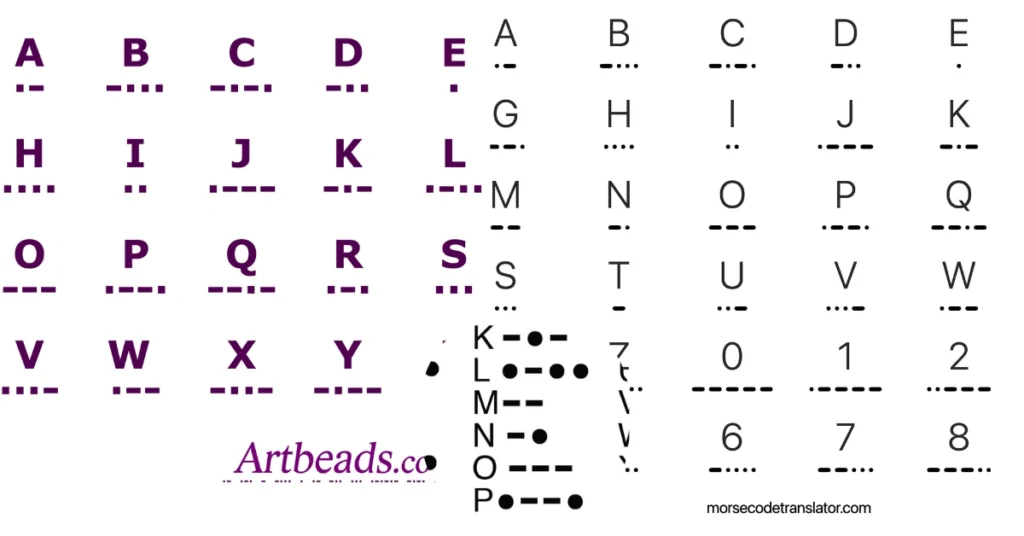Have you ever heard a series of dots and dashes in an old movie or during a radio transmission? That’s the intriguing language of Morse code, a system that has fascinated many for over a century. Whether you’re curious about its origins or eager to learn how to translate Morse code into English, this guide will equip you with the essentials. From decoding messages to understanding its historical significance, let’s delve into this unique form of communication together!
What is Morse Code?
Morse code is a method of encoding text characters using sequences of dots and dashes. Each letter, number, or symbol corresponds to a specific combination of these signals.
Originally developed for telegraph communication in the early 1830s, Morse code revolutionized long-distance messaging. Its simplicity made it easy to transmit over wires or through light signals.
Today, this binary system remains relevant in various forms, including sound and visual signals. It allows for effective communication even in low-tech environments.
Whether you’re tapping out a message on a keyboard or signaling with a flashlight, Morse code bridges gaps when traditional methods fail. Its versatility ensures that it continues to be an important historical and practical tool for conveying information efficiently.
The History of Morse Code
Morse Code emerged in the early 1830s, crafted by Samuel Morse and Alfred Vail. They sought an effective way to communicate over long distances using electrical signals.
The first successful demonstration occurred in 1844. It conveyed the message, “What hath God wrought?” This marked a turning point for communication technology.
Initially used with telegraphs, Morse Code revolutionized how people shared information. Operators tapped out dots and dashes to represent letters and numbers.
Its simplicity allowed swift learning, making it accessible to many. During wartime, operators became vital as they communicated crucial messages swiftly across battlefields.
As radio technology advanced in the 20th century, Morse Code found new life. It became essential for maritime navigation and aviation communication.
Despite emerging digital technologies today, its legacy remains strong within amateur radio communities and survival skills training courses worldwide.
Learning the Basics of Morse Code
Learning the basics of Morse code can be an exciting venture. At its core, this code uses a series of dots and dashes to represent letters and numbers.
Each letter has a unique combination. For example, “A” is represented by a dot followed by a dash, while “B” is three dashes followed by two dots. This simplicity makes it easier to memorize with practice.
Start with the alphabet. Flashcards can help reinforce your memory. Try writing down each letter alongside its Morse representation until you feel comfortable.
Next, familiarize yourself with numbers and punctuation marks too. They follow similar patterns but add another layer of complexity.
Listening exercises are beneficial as well. Find audio resources that play Morse code transmissions. Translating what you hear into English enhances both recognition and comprehension skills over time.
Tools and Equipment Needed for Translation
To translate Morse code into English effectively, you don’t need much. A simple pen and paper can be your best friends in this endeavor. Jotting down dots and dashes helps visualize the message clearly.
Digital tools have made translation easier than ever. Various online translators allow you to input Morse code and receive instant translations. This is a great way to double-check your work.
Apps for smartphones are also handy companions. They often come with built-in converters that let you practice on the go.
A Morse code chart is invaluable as well. You can find printable versions or use digital ones on your device. Having quick access to these symbols saves time during translation efforts.
Some enthusiasts prefer using sound signals, like buzzers or lights, which adds an engaging layer to learning Morse code while enhancing auditory recognition of the language’s rhythmic patterns.
Steps to Translate Morse Code into English
To translate Morse Code into English, start by familiarizing yourself with the Morse alphabet. Each letter corresponds to a unique combination of dots and dashes.
Next, break down the code you want to translate. Write it out clearly on paper or use a digital format. This helps visualize patterns and sequences.
For each character in your message, identify whether it’s represented by dots (short signals) or dashes (long signals). Use reference charts that show these relationships for quick guidance.
As you decode, group letters together to form words. Spaces between characters signify breaks; longer spaces indicate new words.
Keep practicing with different messages. The more exposure you get, the quicker you’ll become at translating Morse Code accurately and efficiently.
Common Abbreviations and Symbols in Morse Code
Morse Code isn’t just letters and numbers; it also includes a variety of common abbreviations and symbols that make communication more efficient. Familiarizing yourself with these can significantly speed up your translation skills.
One frequently used abbreviation is “SOS,” which signifies distress. It’s universally recognized, even beyond Morse enthusiasts.
Another symbol to note is the slash (/) indicating space between words. This small detail helps prevent confusion when translating longer messages.
There are also shorthand notations like “AR” for “end of message” or “SK” to signal “stop keying.” These shortcuts streamline communication, especially in time-sensitive situations.
Understanding these abbreviations enhances your ability to decode messages quickly and accurately, making every Morse endeavor less daunting.
Tips for Practicing and Improving Translation Skills
To enhance your Morse code translation skills, practice is key. Start with simple phrases and gradually increase complexity as you gain confidence.
Listening to Morse code audio clips can significantly speed up your learning. Websites offer free resources where you can hear the dots and dashes in real time.
Another effective method is to write down Morse code messages from English texts. This reinforces memory while familiarizing yourself with common letter patterns.
Join online forums or social media groups dedicated to Morse code enthusiasts. Engaging with others provides motivation and invaluable tips from fellow learners.
Consider using flashcards for quick reference of letters and symbols. They make memorization easier during short practice sessions throughout the day.
Set achievable goals for each session. Whether it’s translating a few words or mastering new abbreviations, small milestones will keep you motivated on this journey.
Applications of Morse Code in Modern Times
Morse code still finds relevance in today’s digital age. It serves as a crucial communication tool for amateur radio operators. These enthusiasts enjoy connecting across vast distances, often using Morse code to overcome signal interference.
Additionally, Morse code is utilized in aviation and maritime navigation systems. Pilots and sailors rely on it for transmitting signals during emergencies when other forms of communication might fail.
Assistive technology also embraces Morse code. For individuals with disabilities, specialized devices allow them to communicate effectively by tapping or blinking out dots and dashes.
Educational settings have not overlooked its value either. Teachers introduce students to Morse code as a fun way to enhance critical thinking skills while learning about historical communication methods.
The growing interest in cryptography has revived the study of Morse code among hobbyists who appreciate its simplicity and charm. Through these applications, this historic system continues to captivate and serve various communities worldwide.
Conclusion
Translating Morse Code into English can be an enjoyable and rewarding skill. With a rich history and practical applications, understanding this unique form of communication opens the door to various opportunities. Whether you’re decoding messages for fun or enhancing your knowledge as part of a hobby, learning Morse code enriches your cognitive abilities.
As you practice translating Morse Code into English, remember that patience is key. Use the tools available to aid your learning and immerse yourself in resources that enhance your skills. The more you engage with Morse code, the easier it will become to recognize patterns and abbreviations.
Mastering this timeless method of communication not only connects us to historical contexts but also keeps alive an intriguing aspect of our modern world. So grab some paper, find those dots and dashes around you, and start translating!
Discover more about AI tools and their applications in our guide on AI Clothes Changers and Free Photo to Video AI Tools.







